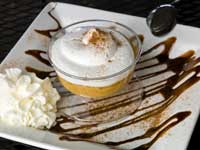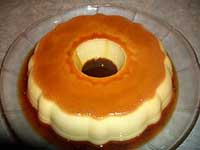Flan
Origin: Spain and other countries
The classic flan or crème caramel is a light and tasty dessert that is extremely popular on the Spanish peninsular, something you will definitely see if you visit Spain. Although it is thought that the flan was invented in the central European regions of France and Germany, in fact the word 'flan' comes from the German 'flado' meaning cake, the humble flan has become popular across the Spanish speaking world.

In fact, the spread of the flan has led to a number of different varieties of the dish. The flan recipe can be adapted for a number of different flavours by replacing the milk in the recipe for another liquid. For example, in the regions of Valencia and Murcia, the country's best sweet oranges are grown and so the flan of these regions is made with freshly squeezed orange juice instead of milk.
If you read any Latin America travel guide, you will find that the variation of the dish tends to be found in the things that accompany the dish. In Argentina, Mexico and Uruguay flans are normally eaten with dulce de leche meanwhile in Chile it is accompanied by dulce de membrillo.
Flans can be a little tricky to make but practice makes perfect! If you think it will be hard to get all the individual flans out of their individual cups, you could always try making a single large flan in a large mould and slice the flan up when you serve it. Also, as flans take a while to cool down, it is best to make them early in the morning or the night before you want to eat them.
Flan | Caramel Custard
Ingredients:
- For the flan:
- 4 cups of whole milk
- 2 strips of lemon zest
- 1 cinnamon stick
- 5 eggs
- 2 extra egg yolks
- 1 cup of granulated sugar
- For the caramelized sugar coating:
- ½ cup of sugar
- Makes 12
Preparation:
- Preheat the oven to 150ºC (300ºF).
- To make the sugar coating, spread out the sugar in an even fashion on the bottom of a heavy saucepan and then put on a medium-high heat. Watch the sugar liquefy at the edges but do not stir, this could take a few minutes. The sugar should change colour slowly, from white to yellow, then to a golden syrup and then to a brown coloured caramel sauce.
- At the point where the sugar is changing from golden to brown, remove the pan from the heat immediately. This is important as if you miss this point, the sugar will taste bitter and you will have to start again.
- Work quickly to pour the liquid caramel sugar into 12 custard cups, around 9 centimetres (3½ inches) in diameter and tilt so that the caramel covers the bottom of the cup and a little up the sides. DO this quickly so that the caramel does not set. Leave the cups to one side.
- Mix together the milk, lemon zest and cinnamon stick in a saucepan and bring to a boil over a high heat. Once boiling, quickly turn the heat to low and then simmer the mixture for 10 minutes so as to infuse the milk with the flavours. Remove the pan from the heat and then leave to cool.
- In a mixing bowl, mix together the eggs, egg yolks and granulated sugar until they are foamy. Pour the cold milk mixture through a fine sieve (to catch the seasoning) into the egg mixture and mix well until all is blended. Pour this mixture into the caramel coated custard cups.
- Arrange the custard cups in a large, deep baking or roasting tray. Pull out the oven shelf and place the baking tray on it. Then carefully fill the pan with boiling water, up to about 3 centimetres (1 inch) up the pan so as to create a water bath.
- Bake the custard cups for about an hour and a half (90 minutes) or until the custard is set when a thin knife is poked into the centre of the cups.
- Carefully remove the tray from the oven and then take out the flans from the water and leave to cool to one side.
- Once cooled to room temperature, you can either serve them or refrigerate them to serve them cold. To serve the flans, run a knife around the inside of each cup to loosen the edges of the flan and then upturn the flan onto a plate and allow to slip out.



